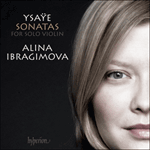
Welcome to Hyperion Records, an independent British classical label devoted to presenting high-quality recordings of music of all styles and from all periods from the twelfth century to the twenty-first.
Hyperion offers both CDs, and downloads in a number of formats. The site is also available in several languages.
Please use the dropdown buttons to set your preferred options, or use the checkbox to accept the defaults.

| Alina Ibragimova (violin)» More |
Like the Sonata No 3, this one is in a single movement. Spanish features—tangos and habaneras—abound but are continually subject to development or interruption by passages of considerable technical difficulty, so that we hear the influence not so much of Bach as of Paganini. Indications such as dolce, grazioso, lusingando, commodo, calando and teneramente emphasize the lyrical quality of Quiroga’s playing, but five fast, high octave runs, including one up to the final cadence, also give an idea of his fine technique.
from notes by Roger Nichols © 2015
Comme la Sonate nº 3, celle-ci est en un seul mouvement. Les éléments espagnols—tangos et habaneras—abondent mais sont continuellement soumis à développement ou à interruption par des passages d’une difficulté technique considérable, si bien qu’on perçoit moins l’influence de Bach que celle de Paganini. Des indications comme dolce, grazioso, lusingando, commodo, calando et teneramente accentuent la qualité lyrique du jeu de Quiroga, mais cinq traits rapides et en octave dans l’aigu, dont celui qui mène à la cadence finale, donnent aussi une idée de sa belle technique.
extrait des notes rédigées par Roger Nichols © 2015
Français: Marie-Stella Pâris
Ebenso wie die Sonate Nr. 3 ist auch diese einsätzig angelegt. Spanische Elemente—Tangos, Habaneras—sind reichlich vorhanden, werden jedoch ständig weiterentwickelt oder von technisch höchst komplexen Passagen unterbrochen, so dass hier nicht so sehr der Einfluss Bachs als vielmehr derjenige Paganinis nachzuvollziehen ist. Anweisungen wie dolce (süß), grazioso (anmutig), lusingando (schmeichelnd), commodo (gemütlich), calando (absinkend) und teneramente (zärtlich) betonen die lyrische Seite von Quirogas Spiel, doch bieten fünf schnelle und hohe Oktavenläufe, von denen einer bis zur Schlusskadenz reicht, ebenfalls einen Einblick in seine ausgezeichnete Technik.
aus dem Begleittext von Roger Nichols © 2015
Deutsch: Viola Scheffel
 Ysaÿe: Sonatas for solo violin Ysaÿe: Sonatas for solo violinTreading confidently in the footsteps of her award-winning Bach Sonatas & Partitas for solo violin, Alina Ibragimova brings to Ysaÿe’s twentieth-century response to these seminal works astonishing tenderness and strident vigour in equal measure.» More |

